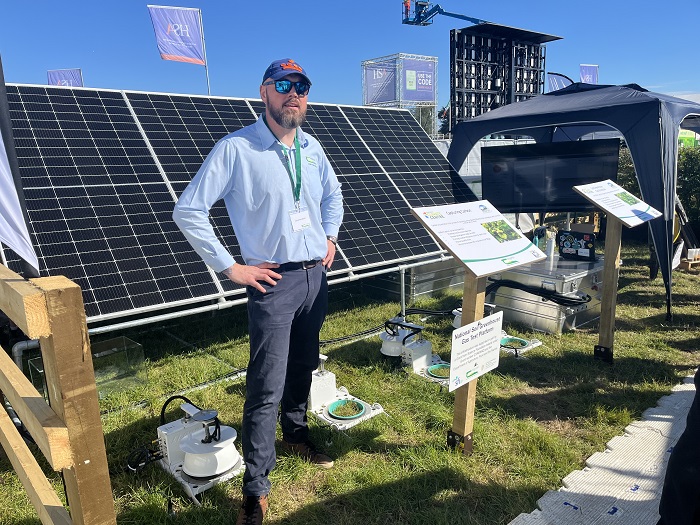17 September 2024
Digging into Solutions: Soils and Carbon Sequestration
Did you know that soil stores 80% of the carbon on land and is the Earth’s second largest carbon storage after oceans? However, not all soils are the same and the amount of carbon stored is dependent on soil type, Dr Muireann Egan of the Teagasc Climate Centre tells us more.
For example, peat soils store more carbon than clay and sandy soils, while grassland stores more carbon than tillage, due to the higher levels of disturbance in tillage soils. Carbon plays an important role in soil health, increasing nutrient and water availability as well as supporting soil biodiversity.

James Rambaud, Technologist in Carbon Emissions & Sequestration at Teagasc, demonstrating real-time measurements of greenhouse gas emissions from soil using technology at the National Ploughing Championships.
Carbon sequestration is the process of capturing carbon dioxide (CO2) from the atmosphere and storing it in either soil or wood. Enhancing carbon sequestration is vital for climate change mitigation and meeting greenhouse gas reduction targets. At farm level, there are a number of measures that can increase carbon capture, including planting trees, forests and hedgerows and increasing hedgerow height and width. Planting clover or multispecies swards, using catch crops and incorporating straw and using manure on tillage soils can also increase carbon capture.
While soils store vast amounts of carbon, they are also a source of greenhouse gas emissions. In fact, over 25% of agricultural greenhouse gas emissions come from soil. For example, the potent greenhouse gas nitrous oxide (N2O) is produced in the soil through microbial processes which utilise nitrogen. However, soil emissions can be reduced by improving soil fertility, spreading low emission fertilisers and using low emission slurry spreading, reducing nitrogen fertiliser rates and planting clover and multispecies swards.
Soil carbon and carbon sequestration is the theme of the Teagasc Climate Centre/Signpost Programme display at Ploughing 2024. Teagasc researchers will demonstrate various soil samples, as well as real-time measurements of greenhouse gas emissions from soil using technology from the Teagasc National Soil Greenhouse Gas Test Platform. Teagasc Signpost advisors will be on hand to answer farmers’ questions about soil carbon and carbon sequestration.
Visit the Teagasc stand at Block 2, Row 12, Stand 201.

